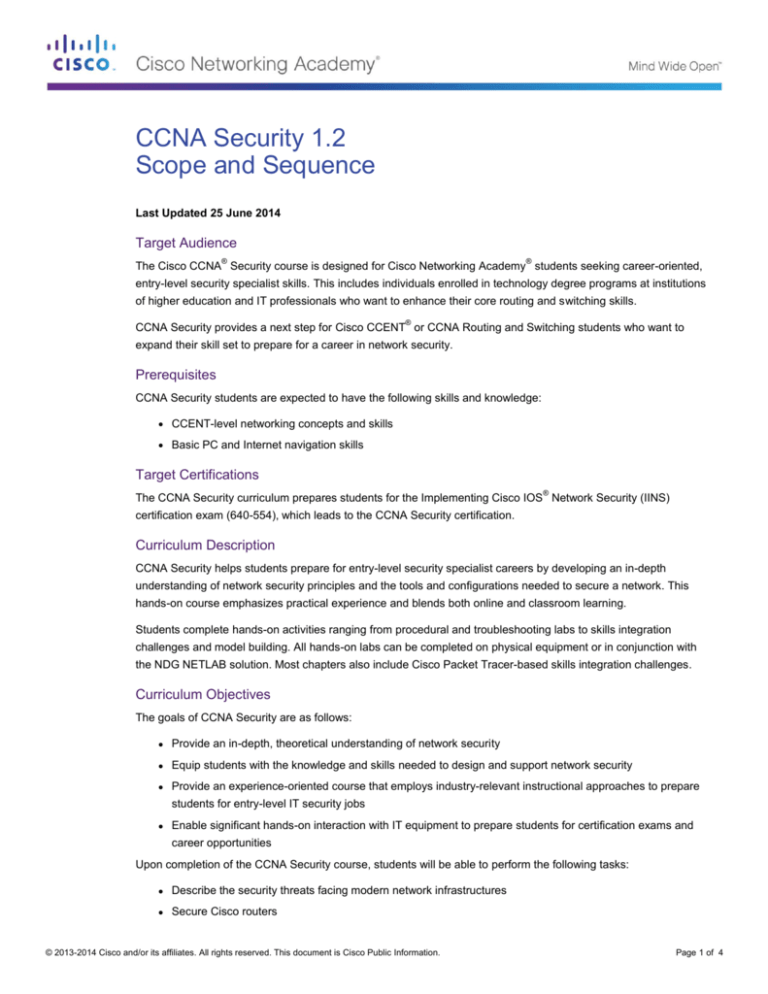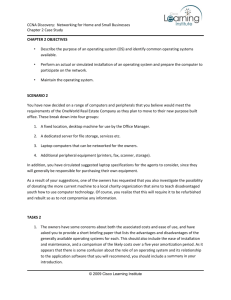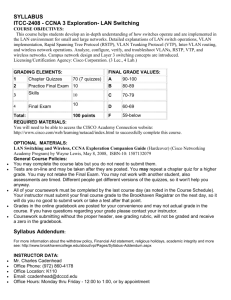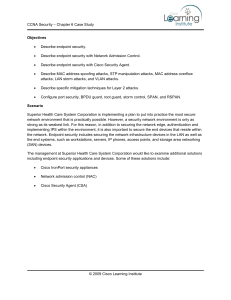
CCNA Security 1.2
Scope and Sequence
Last Updated 25 June 2014
Target Audience
®
®
The Cisco CCNA Security course is designed for Cisco Networking Academy students seeking career-oriented,
entry-level security specialist skills. This includes individuals enrolled in technology degree programs at institutions
of higher education and IT professionals who want to enhance their core routing and switching skills.
®
CCNA Security provides a next step for Cisco CCENT or CCNA Routing and Switching students who want to
expand their skill set to prepare for a career in network security.
Prerequisites
CCNA Security students are expected to have the following skills and knowledge:
●
CCENT-level networking concepts and skills
●
Basic PC and Internet navigation skills
Target Certifications
®
The CCNA Security curriculum prepares students for the Implementing Cisco IOS Network Security (IINS)
certification exam (640-554), which leads to the CCNA Security certification.
Curriculum Description
CCNA Security helps students prepare for entry-level security specialist careers by developing an in-depth
understanding of network security principles and the tools and configurations needed to secure a network. This
hands-on course emphasizes practical experience and blends both online and classroom learning.
Students complete hands-on activities ranging from procedural and troubleshooting labs to skills integration
challenges and model building. All hands-on labs can be completed on physical equipment or in conjunction with
the NDG NETLAB solution. Most chapters also include Cisco Packet Tracer-based skills integration challenges.
Curriculum Objectives
The goals of CCNA Security are as follows:
●
Provide an in-depth, theoretical understanding of network security
●
Equip students with the knowledge and skills needed to design and support network security
●
Provide an experience-oriented course that employs industry-relevant instructional approaches to prepare
students for entry-level IT security jobs
●
Enable significant hands-on interaction with IT equipment to prepare students for certification exams and
career opportunities
Upon completion of the CCNA Security course, students will be able to perform the following tasks:
●
Describe the security threats facing modern network infrastructures
●
Secure Cisco routers
© 2013-2014 Cisco and/or its affiliates. All rights reserved. This document is Cisco Public Information.
Page 1 of 4
●
Implement AAA on Cisco routers using a local router database and external ACS
●
Mitigate threats to Cisco routers and networks using ACLs
●
Implement secure network design, management, and reporting
●
Mitigate common Layer 2 attacks
●
Implement the Cisco IOS firewall feature set
●
Implement the Cisco IOS IPS feature set
●
Implement a site-to-site VPN
●
Implement a remote access VPN
Minimum System Requirements
CCNA Security curriculum requirements:
●
1 Student PC per student; 1 local curriculum server
CCNA Security lab bundle requirements:
Detailed equipment information, including descriptions and part numbers, is available in the official CCNA Security
Equipment List on the Cisco NetSpace™ learning environment. Please refer to that document for the latest
information, which includes specifications for the following minimum equipment required:
●
3 Cisco routers, 2 with the Security Technology Package License
●
3 Two-Port Serial WAN Interface Cards
●
3 Cisco switches
●
1 Cisco Adaptive Security Appliance (ASA)
●
Assorted Ethernet and Serial cables and hubs
The equipment should be set up in the following configuration:
© 2013-2014 Cisco and/or its affiliates. All rights reserved. This document is Cisco Public Information.
Page 2 of 4
CCNA Security Chapter Outline
Chapter/Section
Goals/Objectives
Chapter 1. Modern Network Security Threats
Describe security threats facing modern network infrastructures
1.1 Fundamental Principles of a Secure
Network
Describe the fundamental principles of securing a network
1.2 Viruses, Worms, and Trojan Horses
Describe common network attack methodologies and mitigation
techniques such as Reconnaissance, Access, Denial of Service, and
DDoS
1.3 Attack Methodologies
Describe the characteristics of Worms, Viruses, and Trojan Horses
and mitigation methods
1.4 Cisco Network Foundation Protection
Framework
Describe the Cisco Network Foundation Protection framework to
include the control, management, and data (forwarding) planes
Chapter 2. Securing Network Devices
Secure administrative access on Cisco routers
2.1 Securing Device Access
Configure basic security for local and remote administrative access
2.2 Assigning Administrative Roles
Configure command authorization using privilege levels and role-based
CLI
2.3 Monitoring and Managing Devices
Implement secure management, monitoring, and resiliency of network
devices
2.4 Using Automated Security Features
Secure IOS-based routers using automated features
Chapter 3. Authentication, Authorization, and
Accounting
Secure administrative access with AAA
3.1 Purpose of AAA
Describe the purpose and protocols for implementing AAA
3.2 Local AAA Authentication
Implement AAA on Cisco routers using the local router database
3.3
Implement server-based AAA
Server-Based AAA
3.4 Server-Based AAA Authentication
Implement server-based AAA authentication using TACACS+ and
RADIUS protocols
3.5
Implement server-based AAA authorization and accounting
Server-Based AAA Authorization and
Accounting
Chapter 4. Implementing Firewall
Technologies
Implement firewall technologies to secure the network perimeter
4.1 Access Control Lists
Mitigate threats to Cisco routers and networks using ACLs
4.2 Firewall Technologies
Implement classic firewall to mitigate network attacks
4.3 Zone-Based Policy Firewall
Implement Zone-Based Policy Firewall
Chapter 5. Implementing Intrusion Prevention
Configure IPS to mitigate attacks on the network
5.1 IPS Technologies
Describe network-based and host-based intrusion detection and
prevention
5.2
Describe how signatures are used to detect malicious network traffic
IPS Signatures
5.3 Implementing IPS
Implement Cisco IOS IPS operations using CLI and CCP
5.4 Verify and Monitor IPS
Verify and monitor the Cisco IOS IPS operations using CLI and CCP
Chapter 6. Securing the Local-Area Network
Describe LAN security considerations and implement endpoint
and Layer 2 security features
6.1 Endpoint Security
Describe endpoint vulnerabilities and protective measures
6.2 Layer 2 Security Considerations
Describe Layer 2 vulnerabilities and implement security measures
6.3 Configuring Layer 2 Security
Configure and verify switch security features, including port security
and storm control
6.4 Wireless, VoIP, and SAN Security
Describe Wireless, VoIP, and SAN security considerations
Chapter 7. Cryptographic Systems
Describe methods for protecting data confidentiality and integrity
7.1 Cryptographic Services
Describe how the types of encryption, hashing, and digital signatures
© 2013-2014 Cisco and/or its affiliates. All rights reserved. This document is Cisco Public Information.
Page 3 of 4
provide confidentiality, integrity, authentication, and non-repudiation
7.2 Basic Integrity and Authenticity
Describe the mechanisms used to ensure data integrity and
authentication
7.3 Confidentiality
Describe the mechanisms used to ensure data confidentiality
7.4 Public Key Cryptography
Describe the mechanisms used in a public key cryptography
Chapter 8. Implementing Virtual Private
Networks
Implement secure virtual private networks
8.1 VPNs
Describe the purpose and operation of VPNs
8.2 GRE VPNs
Implement a site-to-site VPN GRE tunnel
8.3 IPSec VPN Components and Operation
Describe the components and operations of IPSec VPNs
8.4 Implementing Site-to-Site IPSec VPNs with
CLI
Use CLI to configure and verify a site-to-site IPSec VPN with preshared key authentication
8.5 Implementing Site-to-Site IPSec VPNs with
CCP
Use CCP to configure and verify a site-to-site IPSec VPN with preshared key authentication
8.6 Implementing Remote-Access VPNs
Configure and verify a remote-access VPN
Chapter 9. Implementing the Cisco Adaptive
Security Appliance (ASA)
Given the security needs of an enterprise, create and implement a
comprehensive security policy
9.1 Introduction to the ASA
Describe the ASA as an advanced stateful firewall
9.2 ASA Firewall Configuration
Implement an ASA Firewall configuration
9.3 ASA VPN Configuration
Configure and verify a remote access VPN on an ASA
Chapter 10. Managing a Secure Network
Implement firewall technologies using the ASA to secure the
network perimeter
10.1 Principles of Secure Network Design
Describe the principles of secure network design
10.2 Security Architecture
Describe the Cisco SecureX Architecture
10.3 Operations Security
Describe the implementation of a comprehensive security policy
10.4 Network Security Testing
Describe the various techniques and tools used for network security
testing
10.5 Business Continuity Planning and Disaster
Recovery
Describe the principles of business continuity planning and disaster
recovery
10.6 System Development Life Cycle
Describe SDLC and how to use it to design a Secure Network Life
Cycle management process
10.7 Developing a Comprehensive Security
Policy
Describe the functions, goals, role, and structure of a comprehensive
security policy
© 2013-2014 Cisco and/or its affiliates. All rights reserved. This document is Cisco Public Information.
Page 4 of 4







